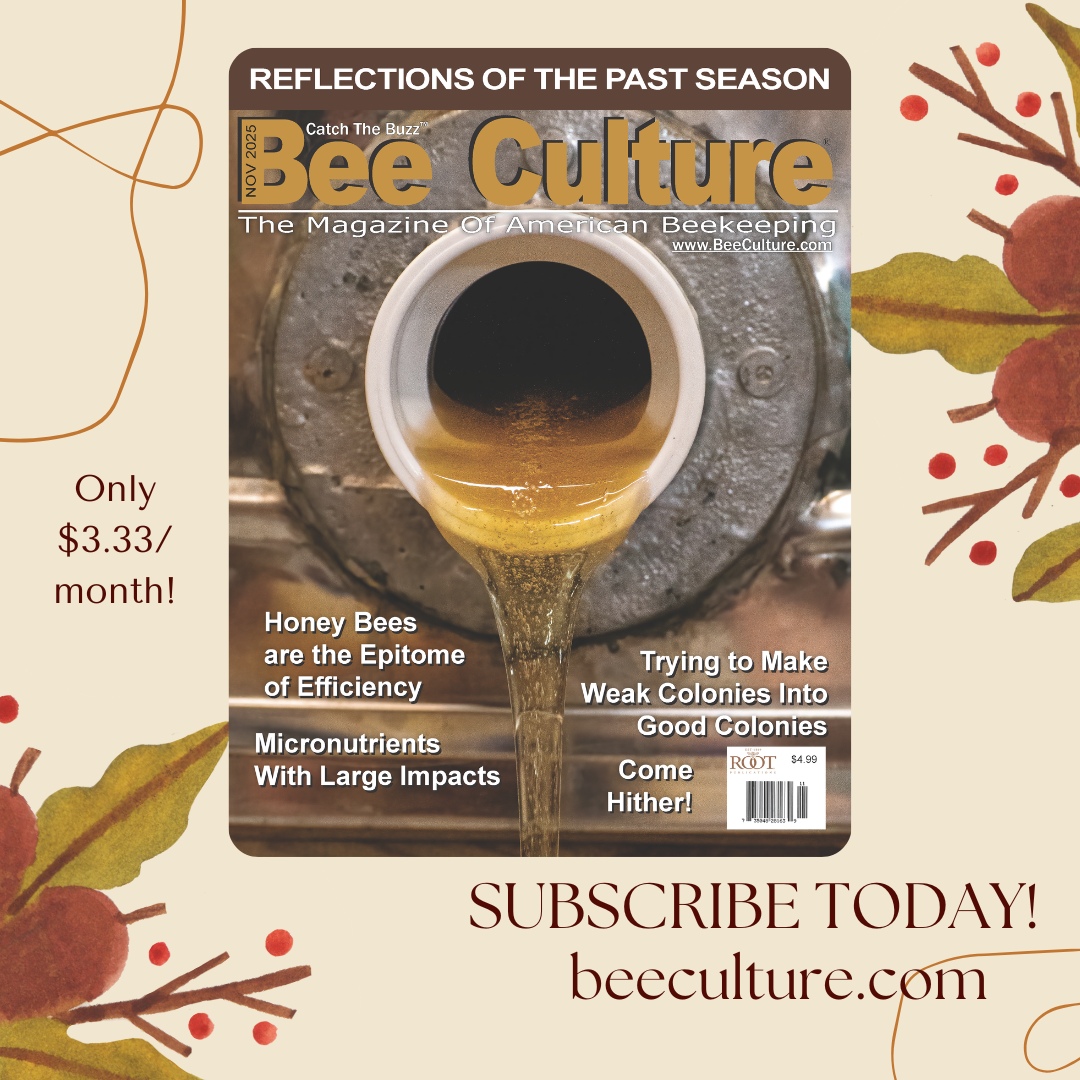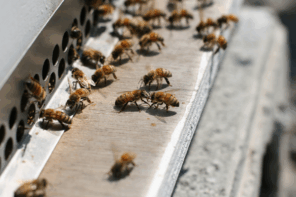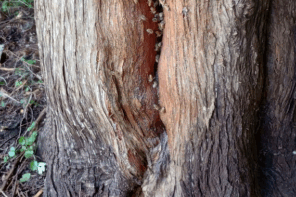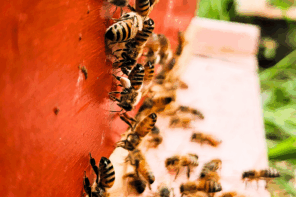 Silent Earth. Averting The Insect Apocalypse. By Dave Goulson. Published by Harper Collins. ISBN 978-0-06-308820-7. 328 pgs., hard cover. $28.99.
Silent Earth. Averting The Insect Apocalypse. By Dave Goulson. Published by Harper Collins. ISBN 978-0-06-308820-7. 328 pgs., hard cover. $28.99.
If you had to take a test to become a beekeeper, this book would be required reading. The author is an entomologist and is interested in all insects, and the information in this book applies to all insects, including the honey bee, but also to people, animals, oceans, farms, ice caps, forests, fields and all the rest of living things. The title sums it up quite well – Silent Earth. Insects are the case study of how we are rapidly destroying the planet.
He begins with a brief history of insects, and how they are disappearing at the rate that, with no changes, 75% of them will be gone in about 50 years. And then he spells out many of the reasons why this future is not a good thing. For instance, about 80% of the world’s population eat insects on a routine basis. This makes more sense than you might think – insects more efficiently covert food and water to edible food, they are nutritious and very low in fat. Moreover, people share no diseases with insects, such as Mad Cow disease or the covid viruses among others. Insects don’t make biological waste, they consume it and turn it into more food by making better soil, they consume pest plants without using chemicals, they eat dead animals, and from our prospective, they are excellent pollinators, producing food.
But, and you knew there was one here, the planet has arrived at the Anthropocene! This is where the earth’s ecosystems and climate are being altered by human activity, represented by an accelerating rate of a decline in biodiversity. One count estimates that since the year 1500 or so, 80+ species of animals and 180 species of birds have become extinct. A 2018 study by The World Wildlife Fund estimates that between 1970 and 2014 the population of all land vertebrates had fallen 60% and the population of all freshwater vertebrates had declined by 81%.
A 26-year study in Europe found that insect biomass declined during that time by 76%, in the U.S. the Western Monarch butterfly population has declined 97% and the Eastern Monarch population by 80%. A study in the UK has measured the butterfly population down an average of 46%, with some species down 77%. There is, sadly, essentially no comparable data from the continents of Africa, South America, Oceania or Asia.
He refers to a shifting baseline in the population of people. Children today do not have experience with millions of Monarchs, for instance. It’s the way it’s always been for them. I compare this to the windshield effect. Remember having to stop on occasion, especially at night in the middle of summer, to clean your windshield of smashed insects? When did you last have to do that? I’ll bet your children wouldn’t believe you if you told them about scraping dead bugs off the windshield so you could actually see to drive.
And then he lists the causes of all this, beginning with the fact that Insects have lost their home. He sums up all of his data with a very interesting quote. “Destroying a rainforest for economic gain is like burning a Renaissance painting to cook a meal.” I think he nailed it there.
He moves on to a Poisoned Land – the evolution of pesticides. He does a bit of history with the discovery of DDT and Parathion in the 40s, both neurotoxins. Paul Hermann Muller received a Nobel Prize for discovering these chemicals.
He moves on to the Neonicotinoids in the 1990s, used as systemic seed coatings, with the poison infiltering all parts of the plant, pollen and nectar included. The LD50 of the most popular brand is one 4 Billionth of a gram, but only 1 – 20% of the chemical is absorbed by the plant, the rest goes into ground water and moves everywhere water goes – streams, rivers, lakes, wells – there has been essentially a global contamination. But the pesticide company’s argument is that with DDT, farmers used about 2000 g/ha, while with the neonics it’s only 10 g/ha.
Fungicides harm bees by killing gut biota, and they also inhibit natural pesticide detoxification in the insects thus increasing even more their lethal effects, but you can’t see that so it doesn’t count. This is followed by the lethal effects of herbicides, primarily glyphosphate, by removing flowers, killing gut bacteria, affecting bees’ learning and orientation capabilities when flying. Plus, iit causes cancer in people.
Fertilizers have a role here too. They change microclimates for caterpillers, destroy alge in ponds allowing toxic cyanobacteria to grow instead, increase methane release from the soils and eventually breaks down into NO2, another warming gas in the atmosphere.
Climate change has a role here too, not surprisingly. The total combined events of heatwaves, drought, wildfires, floods, landslides, avalanches, and storms have changed from about 200/year in 1980 to over 700/year in 2016. We did that, you know.
So, what can be done? Fortunately, more than you might think, if we choose to do it.
Start by raising awareness, convince those with the power to change things to begin. Change farming, become sustainable, reduce monocultures, you can reduce food waste, eat healthier, support local agriculture with community gardens, vote for the right people, use social media, and more, and don’t quit.
He lists the actions that local communities can do, what local governments can do, what national governments can do, and mostly, what farmers can do.
At the end, there is a long, long reading list of resources and supporting information, including the list of references for his data, listed by chapter so you can easily find it when needed. It’s time to get started. Rachael Carson tried with Silent Spring. She started this, but now we have to finish this or it will the be time for a Silent Earth?
Kim Flottum
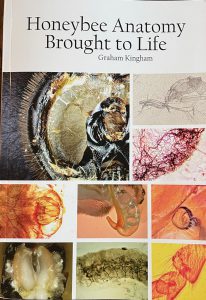 Honeybee Anatomy Brought To Life. By Graham Kingham. Published by and available from Northern Bee Books, UK. 186 pgs. 350 Color and black and white photos and drawing. Soft cover. 6.5” x 9.5”. $44 including postage from UK.
Honeybee Anatomy Brought To Life. By Graham Kingham. Published by and available from Northern Bee Books, UK. 186 pgs. 350 Color and black and white photos and drawing. Soft cover. 6.5” x 9.5”. $44 including postage from UK.
The author started his life in honeybee anatomy by studying for the British Beekeepers Association ‘Microscopy’ exam, one of several exams in their program. We have covered several of these updates in books by Ann Harman and others recently.
He draws heavily on the works of Dade, Goodman, Nelson, Snodgrass and Stell using drawings and photos from some of these, and supplementing them with all of those he has taken.
The book comes in three sections. First, the larval and pupal stages, then adult bees, and finally pests of honeybees.
The line drawings, simplified for easy ID, support and enhance the color photos in each section. And there are lots of both in each section, along with excellent descriptions of what it is you are looking at, along with many arrows showing exactly what you need to see. These are mostly referred to in the text so you can compare the notes to the photos. It makes it much easier to understand what you need to see.
If you intend to do some of these yourself, he offers instructions on how to prepare the specimen so it’s easy to do. For instance, for spiracles, First Shave Your Bee. Very good advice that I would have probably eventually figured out.
Every functioning part is described – glands, the brain, digestion, the fat body, the tracheal system, muscles, heart, nerves, reproduction, flight, sensory organs and all the rest, each as a chapter. And the bonus is a close up look at a varroa mite, tracheal mite, wax moth lava and the common wasp.
You will have this on the table beside you when you begin this adventure in the tiny world of the honeybee, and a few other guests.
Kim Flottum





